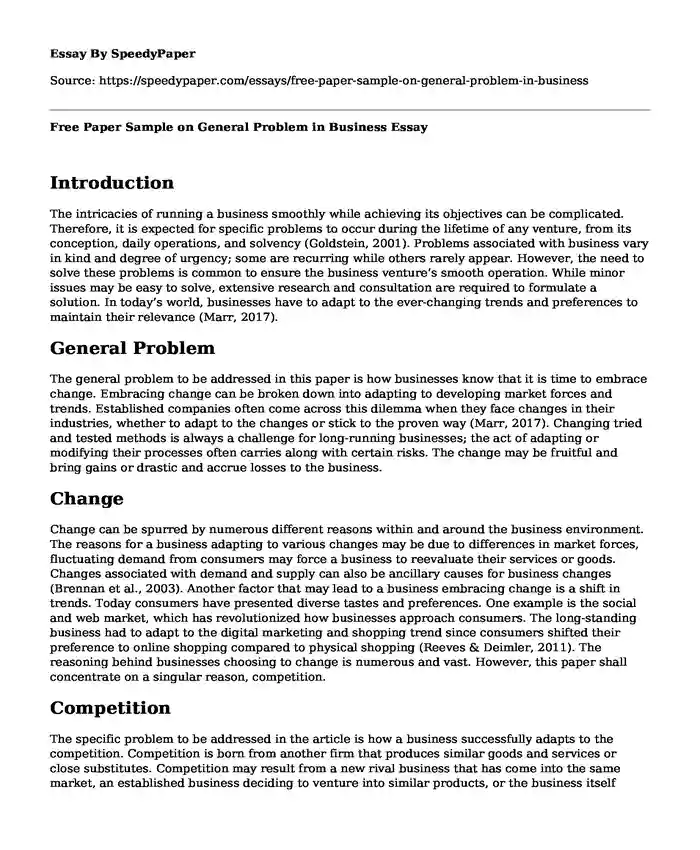
| Type of paper: | Essay |
| Categories: | Business management Business strategy |
| Pages: | 3 |
| Wordcount: | 719 words |
Introduction
The intricacies of running a business smoothly while achieving its objectives can be complicated. Therefore, it is expected for specific problems to occur during the lifetime of any venture, from its conception, daily operations, and solvency (Goldstein, 2001). Problems associated with business vary in kind and degree of urgency; some are recurring while others rarely appear. However, the need to solve these problems is common to ensure the business venture’s smooth operation. While minor issues may be easy to solve, extensive research and consultation are required to formulate a solution. In today’s world, businesses have to adapt to the ever-changing trends and preferences to maintain their relevance (Marr, 2017).
General Problem
The general problem to be addressed in this paper is how businesses know that it is time to embrace change. Embracing change can be broken down into adapting to developing market forces and trends. Established companies often come across this dilemma when they face changes in their industries, whether to adapt to the changes or stick to the proven way (Marr, 2017). Changing tried and tested methods is always a challenge for long-running businesses; the act of adapting or modifying their processes often carries along with certain risks. The change may be fruitful and bring gains or drastic and accrue losses to the business.
Change
Change can be spurred by numerous different reasons within and around the business environment. The reasons for a business adapting to various changes may be due to differences in market forces, fluctuating demand from consumers may force a business to reevaluate their services or goods. Changes associated with demand and supply can also be ancillary causes for business changes (Brennan et al., 2003). Another factor that may lead to a business embracing change is a shift in trends. Today consumers have presented diverse tastes and preferences. One example is the social and web market, which has revolutionized how businesses approach consumers. The long-standing business had to adapt to the digital marketing and shopping trend since consumers shifted their preference to online shopping compared to physical shopping (Reeves & Deimler, 2011). The reasoning behind businesses choosing to change is numerous and vast. However, this paper shall concentrate on a singular reason, competition.
Competition
The specific problem to be addressed in the article is how a business successfully adapts to the competition. Competition is born from another firm that produces similar goods and services or close substitutes. Competition may result from a new rival business that has come into the same market, an established business deciding to venture into similar products, or the business itself venturing into a new market with already established actors (Tanwar, 2013). This research paper shall look into the particulars of competition and the different ways in which a firm can embrace, overcome, and benefit from competition.
Competition may prove to be adverse to the business objectives, or it can temper the business values and production. Competition in any field usually means that the competing entities try to outdo each other in every aspect. In business, firms try to decrease their production costs to have competitive prices; they also increase their products’ quality, trying to edge out their competitors (Brennan et al., 2003).
Conclusion
In these situations, consumers enjoy low prices and high-quality products, but competitiveness in an actual business environment is more complicated. Firms make use of strategies such as cost leadership, differentiation, and focus on trying to emerge as the consumers’ preference. These strategies require extensive market awareness, thus market research (Tanwar, 2013). The competition allows businesses to be innovative, improve their public relations and customer relationship, which, in perspective, enhances the business and the industry at large.
References
Brennan, D. R., Turnbull, P. W., & Wilson, D. T. (2003). Dyadic adaptation in businesstobusiness markets. European Journal of Marketing.
https://doi.org/10.1108/03090560310495393
Goldstein, A. S. P. D. (2001). Solving Business Problems. Made Ez Products.
Marr, B. (2017). The 10 biggest challenges businesses face today (and need consultants for) - Hiscox Business Blog. Hiscox.Co.Uk; Hiscox.
https://www.hiscox.co.uk/business-blog/the-10-biggest-challenges-businesses-face-today-and-need-consultants-for
Reeves, M., & Deimler, M. (2011). Adaptability: The New Competitive Advantage (pp. 135-41). Harvard Business Review.
https://hbr.org/2011/07/adaptability-the-new-competitive-advantage
Tanwar, R. (2013). Porter’s generic competitive strategies. Journal of business and management, 15(1), 11-17. https://www.ifm.eng.cam.ac.uk/research/dstools/porters-generic-competitive-strategies/.
Cite this page
Free Paper Sample on General Problem in Business. (2023, Nov 24). Retrieved from https://speedypaper.net/essays/free-paper-sample-on-general-problem-in-business
Request Removal
If you are the original author of this essay and no longer wish to have it published on the SpeedyPaper website, please click below to request its removal:
- Automotive Industry Analysis Sample
- Free Essay with CEMEX Research and Recommended Strategies
- Free Essay Sample: Social Entrepreneurship and Business Management
- Essay Sample Analyzing the Cases of the Montes Calcados and Blackberry Companies
- Free Essay on Problems in Strategic Planning
- Paper Sample on Service Philosophy
- Marketing Strategy Business Report
Popular categories




